
views
Cutting Face-Framing Layers

Start with dry hair that's parted down the center. This method will focus on cutting hair on someone else. Ask the other person to show you how long they would like their layers and how much hair they want cut.

Section off the top of your client's hair. This section needs to span the width of their forehead. Start it at the corners of their forehead where the hairline curves down. Part it backwards until you reach the crown of the head. Comb the section forward, twist it, and clip it out of the way.
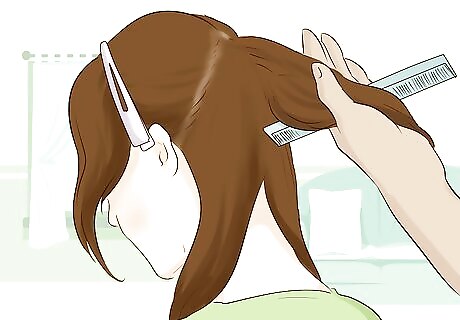
Create a vertical part going from ear-to-ear. Drag your comb from the center part straight down to just behind your client's left ear. Twist and clip the hair behind the ear out of the way, and leave the hair in front of the ear hanging loose. Repeat this step for the right side.
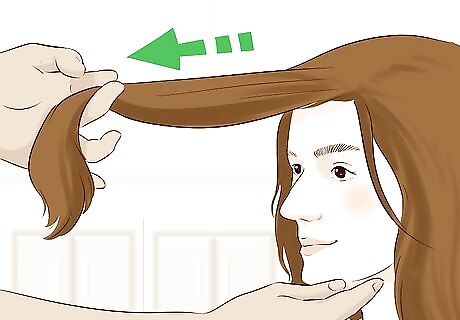
Hold the hair where you want to make the cut with your fingers. Pinch the sectioned hair between your middle and index finger, holding them horizontal across the hair. Slide your fingers down where you want the shortest layer to land. Hold the hair out and away from the face. Take a small strand of hair and measure it against the face to see where it lands. Mark where you would like the shortest layer with your fingers, and use that to guide your length. For hair that falls past the shoulders, somewhere around jaw-length would be ideal. For hair that ends above the shoulders, somewhere around nose-length would work great. Vidal Sassoon, Hairstylist To create flattering V-shaped layers, determine the length based on bone structure and face shape. Cut vertical sections at angles, longest in front and shorter towards the back. Point-cut into the interior hair to remove weight and create movement.
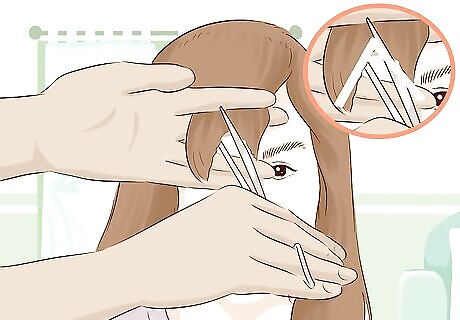
Cut a V shape into the hair below your fingers. While still pinching the hair, cut upwards, making an upside down V-shape just below your fingers. Both sides of the V-shape should be the same length. Once you finish the cut, run a comb under the hair to straighten it back out. Use 7-inch (18-cm) dry cutting shears for best results.
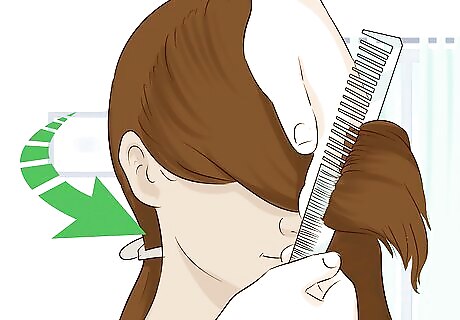
Comb the left side section forward and join it to longest front strand. Drop the entire front section of hair, except for the longest strand on the left side edge. Grab the left side section (all of the hair in front of the left ear) and pull it forward. Add the long strand from the front section to it. Keep the newly-gathered section horizontal and parallel to the floor. Hold it out in front of the client's face; don't drag it across.

Cut diagonally from the shortest strand down to the longest. The leftover strand from your front section is now the shortest. Cut at an angle starting at the shortest front strand and finishing at the longest back strand. How steep the angle is depends on the difference in lengths between the two edges. You can also cut at a shallower angle, but this will shorten the overall length of the haircut.

Repeat the process on the right side of the head. Join the right side of the front strand to the right side section. Pull the hair forward and cut at an angle, starting from the shortest strand and finishing at the longest.
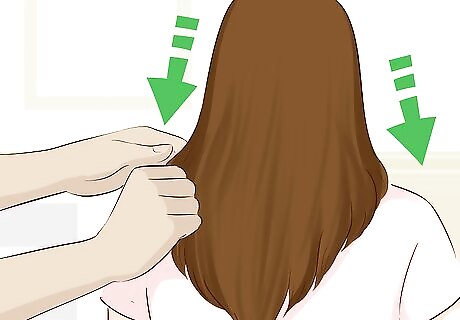
Remove the back clips, then make any touch-ups. Remove the clips first, then comb out the hair. Check to make sure that the side sections flow into the back sections smoothly. If there is a significant difference in length, cut the hair accordingly. You can do this by measuring the back strands against the longest side strands, then cutting them. You can also compare two strands from each side of the head to see if they are the same length.
Creating a V Shaped Cut
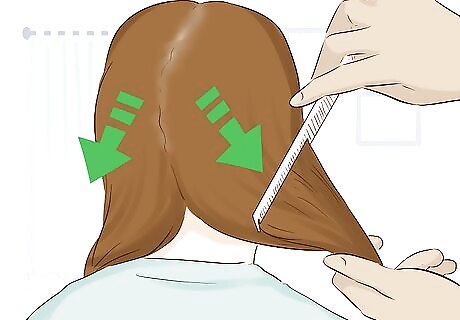
Start with wet hair that's parted into 4 sections. Part the hair down the center first, going from the forehead down to the nape of the neck. Next, create a part going across the top of the head like a headband, from just behind the left ear to just behind the right ear. This style will give you some face-framing layers that angle down into a V shape on the back. This method is meant for cutting someone else's hair, but you can alter some of the techniques to cut your own.
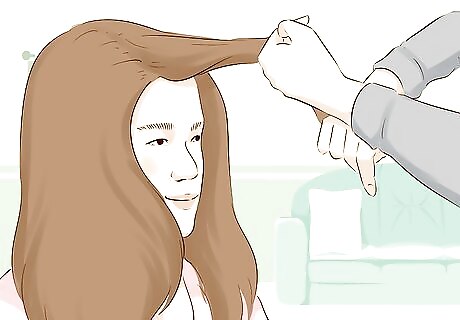
Create a cutting guide for the shortest layer in the front. Take a thin strand of hair from the hairline, right at the center part. Pinch it between your index and middle fingers where you wish to cut it, then snip the hair off below your fingers. Something around nose-length will give a very heavily layered look. If your client has very long hair or if they like to wear their hair in ponytails, make it about jaw-length instead. Hold the scissors so that they are almost vertical. Snip upwards into the hair instead of making an horizontal cut. This will keep the ends from being too blunt.
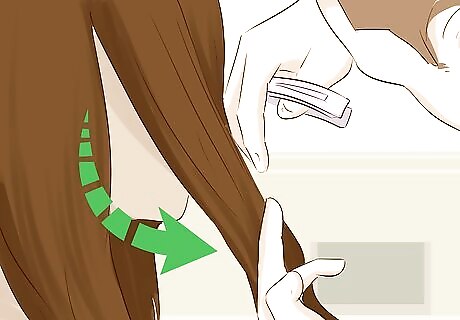
Gather an angled section of hair on the left side and add it to the guide. Place the edge of your comb on the center part, a few finger widths behind the hairline. Drag it towards the hairline, aligning it with the inner corner of the eye/inside of the nose. Add this section to your central guide.
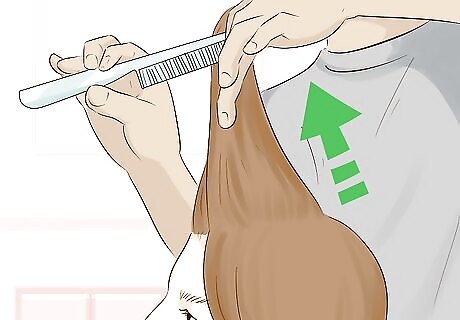
Comb the hair upward, keeping your comb parallel to the angled part. Run your comb under the section of hair, pulling the hair upward. Tilt the comb so that it is parallel to the angled part on the client's head. Make sure that the comb is just below the end of the central guide strand so that you have room to cut. Use a comb color that contrasts with your client's hair. This will make it easier to see.
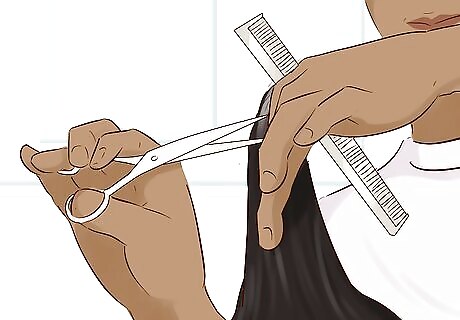
Replace the comb with your index and middle fingers before cutting. Pinch the hair between your fingers. Make sure that they are parallel to the part's angle. Flip the hair over your index finger and cut it so that it is the same length as the central guide. This will create a face-framing cut on the front. Use a pair of 7-inch (18-cm) dry cutting shears for this.
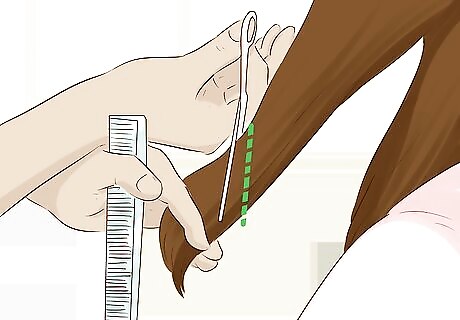
Create another angled section and cut it using the same technique. Create another angled part just behind the first one. Keep it parallel to the first cut. Comb the hair forward into the previous cut before cutting the hair. Repeat combing the hair forward and cutting until you reach the vertical part, then do the other side. Measure the uncut strands against a previously-cut strand. Pull hair from both sides of the head together to see if they are the same length or not. As you continue to cut the hair, you'll notice it naturally taking on an angled, V shaped cut.
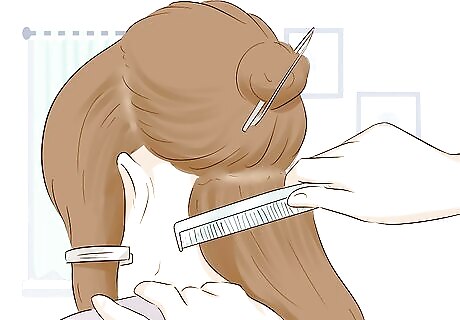
Part the hair in the back and clip one side out of the way. Remove the clips holding the back sections of the hair. Part the hair vertically down the middle, aligning it with the center part on the top of the head. Choose a side to start with and clip the other out of the way.
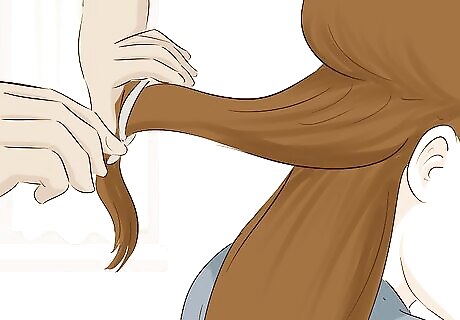
Create a new diagonal section behind the last angled part. Start the new section at the top center part, just behind last angled part. Angle it towards the ear until it touches the last angled part.
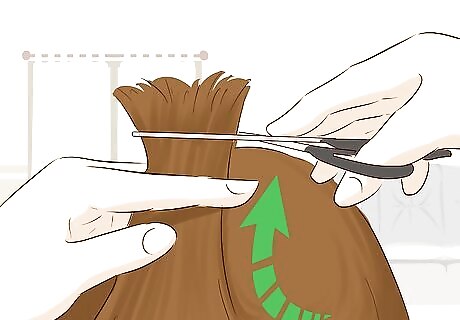
Comb the hair upward and cut it. Use the same technique as you did for the front sections. Match the comb's angle to the part's angle, measure the hair against a previously-cut strand, and cut it.
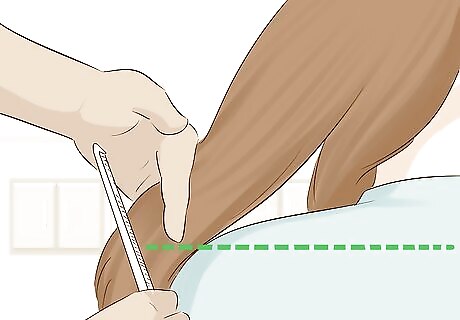
Repeat the process until you reach the nape. As you continue to cut row by row, the angles will straighten out and become parallel to the nape. Continue pulling the hair up past the ear. When you are done, repeat for the other side.

Comb the hair down and cut off any excess length. By now, you should have a rough V shape. Clean up the shape of the V with your shears. The bottom of the V may have a few longer strands of hair, making it look like a Y. If this is the case, simply snip off the stem of the Y to make it a V.




















Comments
0 comment